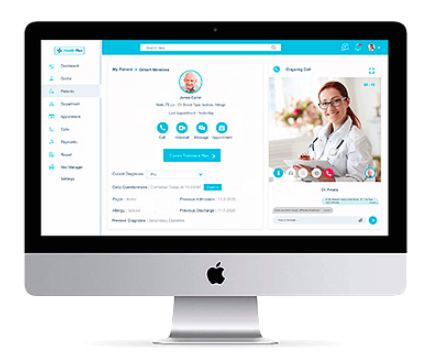
Telehealth integration
Telehealth integration refers to the seamless incorporation of remote patient monitoring (RPM) technology into telehealth platforms, enhancing patient monitoring and care. This integration allows healthcare providers to remotely monitor patients' health conditions, collect vital signs data, and provide timely interventions, all without the need for in-person visits.
The COVID-19 pandemic has accelerated the adoption of telehealth and RPM technologies, revolutionizing the way healthcare is delivered. Telehealth integration for RPM offers numerous benefits and has the potential to greatly improve patient outcomes and quality of care.
RPM benefits
Remote patient monitoring (RPM) enables healthcare providers to proactively monitor patients' health conditions from a distance, improving care coordination and allowing for early interventions when necessary. This technology has several key benefits:
1. Continuous monitoring
RPM enables continuous monitoring of patients' vital signs, such as heart rate, blood pressure, glucose levels, and oxygen saturation. This frequent data collection provides a comprehensive view of the patient's health status, allowing healthcare providers to identify any concerning trends or abnormalities promptly.
2. Early detection of complications
By regularly monitoring patients' health conditions, healthcare providers can identify potential complications at an early stage. For example, in patients with chronic conditions like diabetes or heart disease, RPM can alert healthcare providers to fluctuations in blood sugar levels or irregular heart rhythms, enabling timely interventions and preventing serious complications.
3. Improved medication adherence
RPM can also help improve medication adherence among patients. By remotely monitoring their medication adherence, healthcare providers can identify and address any issues or barriers that may arise, such as forgetfulness or side effects. This proactive approach can significantly improve patient outcomes.
4. Reduced healthcare costs
Telehealth integration with RPM has the potential to reduce healthcare costs. By remotely monitoring patients' health conditions, healthcare providers can identify and address potential health issues before they escalate, potentially preventing costly emergency department visits or hospitalizations. Additionally, RPM can reduce the need for frequent in-person visits, saving patients both time and money.
5. Enhanced patient engagement
RPM engages patients in their own healthcare by providing them with real-time access to their health data. Patients can actively participate in their treatment plans and make informed decisions about their lifestyle choices. This increased engagement can lead to better patient satisfaction and improved health outcomes.
Digital healthcare solutions
The integration of telehealth and RPM relies on various digital healthcare solutions that facilitate the collection, transmission, and analysis of patient data.
1. Remote monitoring devices
Remote monitoring devices such as wearable sensors, smart home technology, and mobile health applications play a crucial role in RPM. These devices collect patients' vital signs and other health-related data, which is then transmitted securely to healthcare providers for analysis and monitoring.
2. Telehealth platforms
Telehealth platforms serve as a virtual hub for healthcare providers and patients to interact and exchange information. These platforms enable secure communication, video consultations, and the sharing of vital signs data. They also facilitate remote patient monitoring by providing alerts and notifications to healthcare providers based on predetermined thresholds.
3. Data analytics and artificial intelligence
Data analytics and artificial intelligence (AI) technologies are essential in identifying meaningful patterns and trends within the vast amount of data collected through RPM. By analyzing this data, healthcare providers can gain valuable insights and make data-driven decisions to enhance patient monitoring and care.
4. Electronic health records (EHRs)
Integrating RPM data into electronic health records (EHRs) ensures seamless access to patients' comprehensive health records, enabling healthcare providers to make informed decisions and tailor treatment plans accordingly. EHR integration also allows for better care coordination among multiple healthcare providers involved in a patient's care.
Conclusion
Telehealth integration for remote patient monitoring (RPM) is revolutionizing healthcare delivery, enhancing patient monitoring, and improving the quality of care. Through continuous monitoring, early detection of complications, improved medication adherence, reduced healthcare costs, and enhanced patient engagement, RPM offers numerous benefits for both patients and healthcare providers.
The use of digital healthcare solutions such as remote monitoring devices, telehealth platforms, data analytics, artificial intelligence, and electronic health records plays a vital role in enabling telehealth integration for RPM. These technologies facilitate the collection, transmission, and analysis of patient data, allowing healthcare providers to remotely monitor patients' health conditions without the need for in-person visits.
As telehealth continues to evolve, telehealth integration RPM will play an increasingly significant role in delivering patient-centered, accessible, and efficient healthcare. It empowers patients to be actively involved in their own care while providing healthcare providers with real-time data to make informed decisions and provide timely interventions, ultimately leading to better patient outcomes and improved quality of care.



























